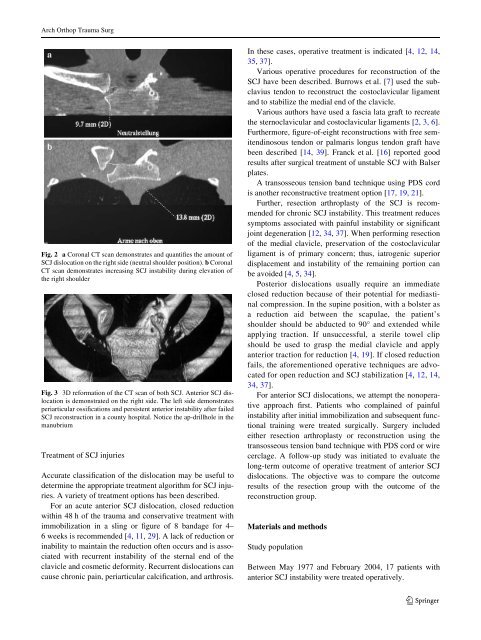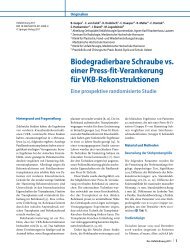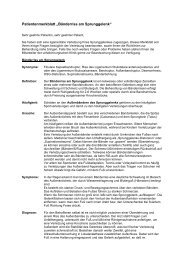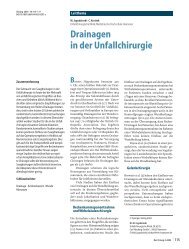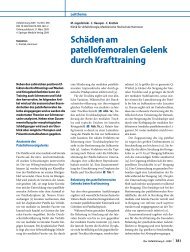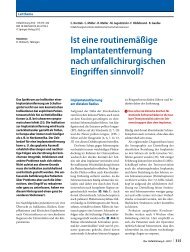Long-term outcome after joint reconstruction or ... - ResearchGate
Long-term outcome after joint reconstruction or ... - ResearchGate
Long-term outcome after joint reconstruction or ... - ResearchGate
You also want an ePaper? Increase the reach of your titles
YUMPU automatically turns print PDFs into web optimized ePapers that Google loves.
Arch Orthop Trauma Surg<br />
Fig. 2 a C<strong>or</strong>onal CT scan demonstrates and quantiWes the amount of<br />
SCJ dislocation on the right side (neutral shoulder position). b C<strong>or</strong>onal<br />
CT scan demonstrates increasing SCJ instability during elevation of<br />
the right shoulder<br />
Fig. 3 3D ref<strong>or</strong>mation of the CT scan of both SCJ. Anteri<strong>or</strong> SCJ dislocation<br />
is demonstrated on the right side. The left side demonstrates<br />
periarticular ossiWcations and persistent anteri<strong>or</strong> instability <strong>after</strong> failed<br />
SCJ <strong>reconstruction</strong> in a county hospital. Notice the ap-drillhole in the<br />
manubrium<br />
Treatment of SCJ injuries<br />
Accurate classiWcation of the dislocation may be useful to<br />
de<strong>term</strong>ine the appropriate treatment alg<strong>or</strong>ithm f<strong>or</strong> SCJ injuries.<br />
A variety of treatment options has been described.<br />
F<strong>or</strong> an acute anteri<strong>or</strong> SCJ dislocation, closed reduction<br />
within 48 h of the trauma and conservative treatment with<br />
immobilization in a sling <strong>or</strong> Wgure of 8 bandage f<strong>or</strong> 4–<br />
6 weeks is recommended [4, 11, 29]. A lack of reduction <strong>or</strong><br />
inability to maintain the reduction often occurs and is associated<br />
with recurrent instability of the sternal end of the<br />
clavicle and cosmetic def<strong>or</strong>mity. Recurrent dislocations can<br />
cause chronic pain, periarticular calciWcation, and arthrosis.<br />
In these cases, operative treatment is indicated [4, 12, 14,<br />
35, 37].<br />
Various operative procedures f<strong>or</strong> <strong>reconstruction</strong> of the<br />
SCJ have been described. Burrows et al. [7] used the subclavius<br />
tendon to reconstruct the costoclavicular ligament<br />
and to stabilize the medial end of the clavicle.<br />
Various auth<strong>or</strong>s have used a fascia lata graft to recreate<br />
the sternoclavicular and costoclavicular ligaments [2, 3, 6].<br />
Furtherm<strong>or</strong>e, Wgure-of-eight <strong>reconstruction</strong>s with free semitendinosous<br />
tendon <strong>or</strong> palmaris longus tendon graft have<br />
been described [14, 39]. Franck et al. [16] rep<strong>or</strong>ted good<br />
results <strong>after</strong> surgical treatment of unstable SCJ with Balser<br />
plates.<br />
A transosseous tension band technique using PDS c<strong>or</strong>d<br />
is another reconstructive treatment option [17, 19, 21].<br />
Further, resection arthroplasty of the SCJ is recommended<br />
f<strong>or</strong> chronic SCJ instability. This treatment reduces<br />
symptoms associated with painful instability <strong>or</strong> signiWcant<br />
<strong>joint</strong> degeneration [12, 34, 37]. When perf<strong>or</strong>ming resection<br />
of the medial clavicle, preservation of the costoclavicular<br />
ligament is of primary concern; thus, iatrogenic superi<strong>or</strong><br />
displacement and instability of the remaining p<strong>or</strong>tion can<br />
be avoided [4, 5, 34].<br />
Posteri<strong>or</strong> dislocations usually require an immediate<br />
closed reduction because of their potential f<strong>or</strong> mediastinal<br />
compression. In the supine position, with a bolster as<br />
a reduction aid between the scapulae, the patient’s<br />
shoulder should be abducted to 90° and extended while<br />
applying traction. If unsuccessful, a sterile towel clip<br />
should be used to grasp the medial clavicle and apply<br />
anteri<strong>or</strong> traction f<strong>or</strong> reduction [4, 19]. If closed reduction<br />
fails, the af<strong>or</strong>ementioned operative techniques are advocated<br />
f<strong>or</strong> open reduction and SCJ stabilization [4, 12, 14,<br />
34, 37].<br />
F<strong>or</strong> anteri<strong>or</strong> SCJ dislocations, we attempt the nonoperative<br />
approach Wrst. Patients who complained of painful<br />
instability <strong>after</strong> initial immobilization and subsequent functional<br />
training were treated surgically. Surgery included<br />
either resection arthroplasty <strong>or</strong> <strong>reconstruction</strong> using the<br />
transosseous tension band technique with PDS c<strong>or</strong>d <strong>or</strong> wire<br />
cerclage. A follow-up study was initiated to evaluate the<br />
long-<strong>term</strong> <strong>outcome</strong> of operative treatment of anteri<strong>or</strong> SCJ<br />
dislocations. The objective was to compare the <strong>outcome</strong><br />
results of the resection group with the <strong>outcome</strong> of the<br />
<strong>reconstruction</strong> group.<br />
Materials and methods<br />
Study population<br />
Between May 1977 and February 2004, 17 patients with<br />
anteri<strong>or</strong> SCJ instability were treated operatively.<br />
123


